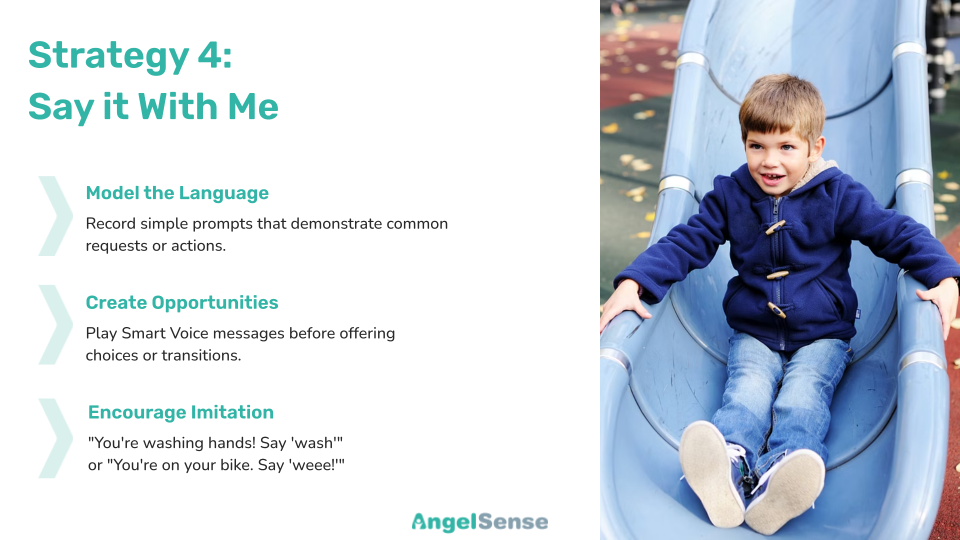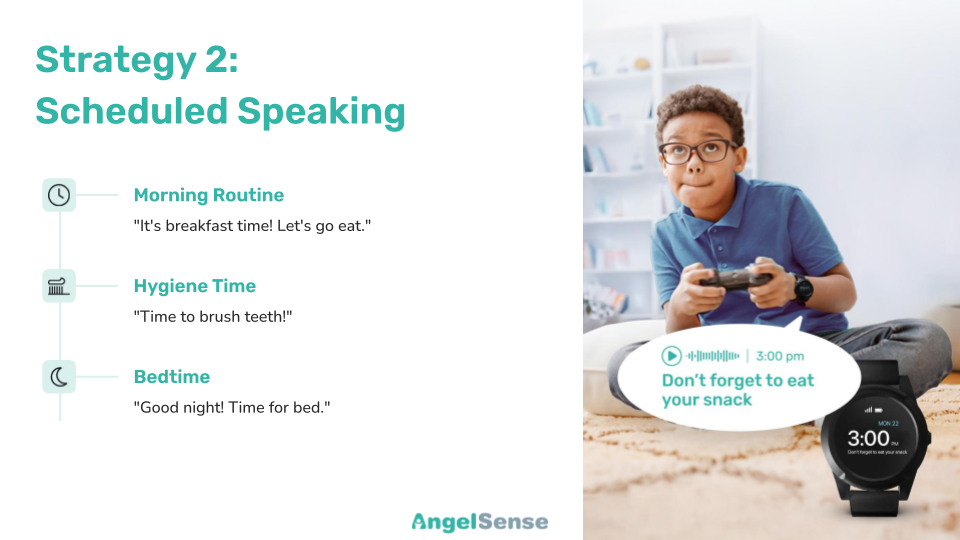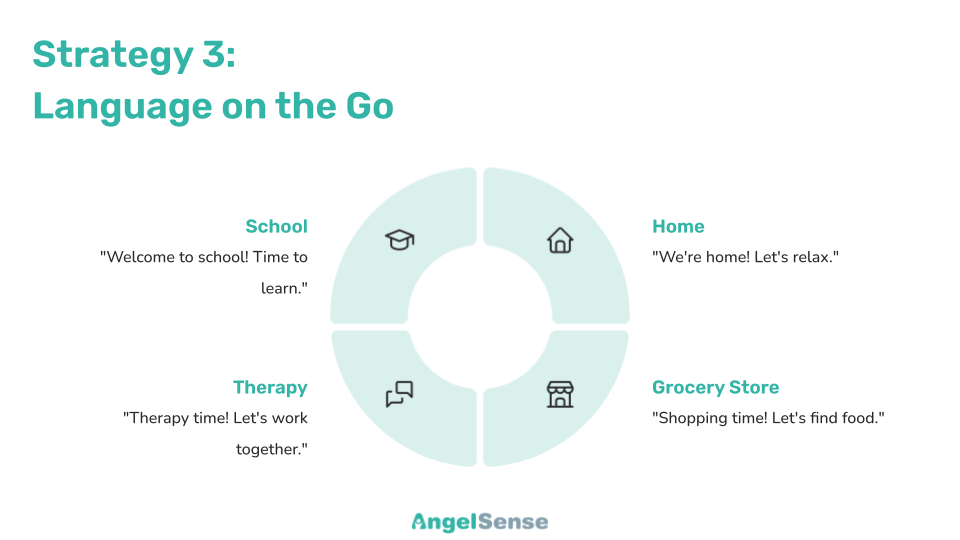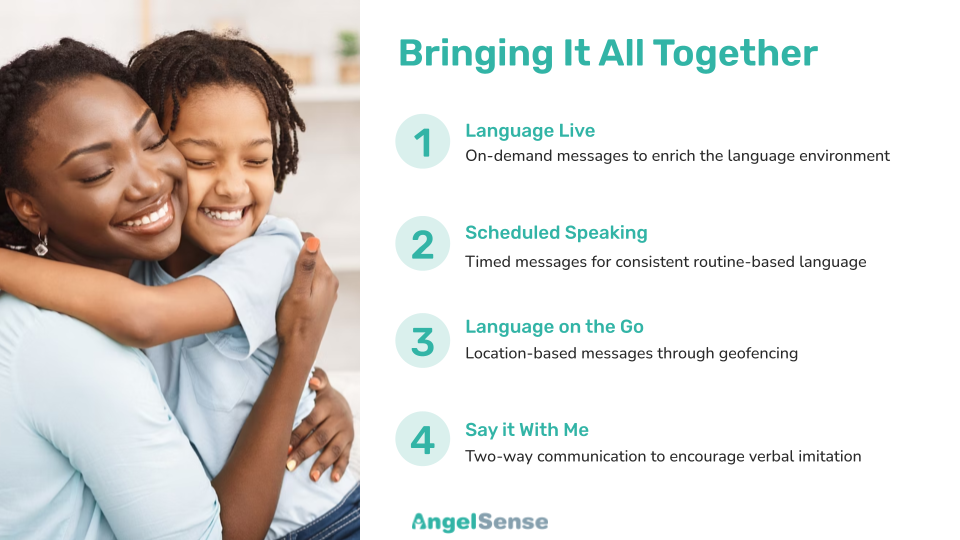How to Support Language Development for Nonverbal & Minimally Verbal Individuals
Updated on July 10, 2025 Listen to the PodcastAs parents and caregivers, we wear many hats, from chef and guide to therapist and chauffeur. For those supporting loved ones who are nonverbal or minimally verbal, fostering communication can feel like just one more overwhelming task. But what if meaningful language learning could happen in the simplest moments of your day?
At AngelSense, we believe assistive technology should go beyond safety. While it’s built to protect, it’s also designed to empower. We’ve heard from families like Melissa’s, whose son was once considered nonverbal and now speaks in full phrases, that the right tools can help unlock a child’s voice.
Building language skills requires repeated, meaningful exposure to words and phrases in real-world settings. Many nonverbal or minimally verbal individuals understand far more language than they can express. When we integrate language into their everyday routines, we create natural opportunities for learning because the words are directly tied to what they’re doing.
Typical spoken language in these settings can be hard for them to focus on due to background noise or distractions. But the AngelSense speakerphone—through features like Smart Voice and the 2-Way Call—offers language that is clear and distinct. This makes it easier to hear and process, creating more effective opportunities for language enrichment.
Why use the AngelSense Speakerphone for language?
The speakerphone provides auditory input that is distinct from environmental noise and is attached to the individual, making them more likely to hear it. Children often attend to and repeat language from electronic devices, songs, or videos because the sound is different. The AngelSense speakerphone delivers language in a clear, distinct way,and is often easier to attend to than spoken language from someone in the room..
Crucially, using the speakerphone can deliver language without interrupting what the child is doing or demanding their attention away from their activity. The language comes through while they stay focused on the task, helping them associate words with actions, objects, and routines. Messages, especially recorded ones, use your voice, so they’re familiar and comforting, yet are delivered clearly and consistently.
4 Practical Strategies to Use AngelSense for Language Enrichment
- Language Live: This strategy uses the Smart Voice on demand for in-the-moment language programming without needing to speak directly to the individual in person. You record concise messages related to specific items or activities. For example, if your child is playing with a red ball, you could play a pre-recorded message saying “red ball” or “find the red ball” as they interact with it. This offers clear, consistent language linked directly to the activity or item.
This kind of consistent, direct language avoids what’s often called “language pollution”, when you’re using too many words at once. Instead, you’re providing simple, clear phrases that are easy to associate with what they’re seeing or doing. This is especially effective in environments with limited distractions or limited item options.
- Scheduled Speaking: This strategy involves recording Smart Voice messages that play at predictable times corresponding to daily routines. You can schedule messages like “It’s time for breakfast,” “Go brush your teeth,” or “Time to get ready for bed” to play right before these activities. This is an automated way to prompt routines and build consistent word-to-activity associations. Hearing “brush your teeth” followed by the action helps them connect the words with the routine. This strategy is relevant for individuals of all ages with limited communication, including adults and the elderly, for prompts like “Take your medication”. The goal is consistent auditory association, not necessarily immediate receptive following of instructions.
Over time, your child may begin to understand the words and even repeat them. This works for all ages, including older individuals who benefit from structured cues like “Take your medication.” Even if your child doesn’t respond right away, hearing the message repeatedly in context helps them internalize the language.
- Language On The Go: This strategy uses Smart Voice messages that automatically play upon arrival at or departure from named places. Named places are locations you set up in the AngelSense app. Messages like “Welcome to school, time to learn,” “This is home, welcome home,” or “Bye-bye therapy, see you later” can be scheduled. Once set up, this strategy is completely hands-free. It provides consistent exposure to language associated with specific places and helps individuals associate phrases with places, which can also be extremely beneficial in reducing anxiety around transitions.
Families have observed their children gradually starting to repeat short arrival messages like “school” or “store,” helping to build spontaneous language. This is also beneficial for adults and the elderly for providing language cues in familiar locations.

- Say It With Me: This strategy utilizes the Two-Way Speakerphone to model language in real-time and prompt verbal imitation. While the individual is engaged in an activity, you can use the speaker to say a relevant word or phrase, like saying “say wash” while they are washing their hands or “say hello” as they greet someone.
This strategy helps them link language to their own actions while encouraging verbal imitation. You can even listen to hear if they repeat the word, then respond with praise or support. The goal is to gently shape verbal behavior without interrupting their activity or demanding direct engagement. It’s important to get excited about approximations or attempts at the word, helping them build fluency over time. This method provides language for what they are doing without requiring them to shift their attention between the activity and you in person.
Everyday Moments, Lifelong Language
These strategies are not intended to replace traditional therapies but to provide essential language enrichment in natural, everyday moments where language learning can be most impactful. Language learning happens most strongly in everyday situations where individuals see how language applies. It’s like a muscle that needs consistent exercise.
Consistent exposure to clear, repeatable messages builds understanding. And even behaviors like echolalia (repeating familiar phrases) can evolve into functional communication when tied to real-life activities.
Ultimately, using AngelSense for language enrichment, alongside patience, consistency, and celebrating every step of progress, can truly help your loved one find their voice and build independence. Whether it’s a few words or full sentences, every step forward is worth celebrating.
Get peace of mind from AngelSense, the groundbreaking AI-based assistive technology designed to enhance safety and peace of mind for individuals with special needs and their families. Our solution ensures you stay connected with your loved ones, empowering a higher level of independence while maintaining safety. Learn more about how AngelSense can make a difference for your family.






